Poland have been drawn with Spain, Sweden and Slovakia for the upcoming UEFA Euro 2020 and this group E will certainly not be easy for either team and especially Poland. Nevertheless, this team has got what it takes to compete for one of the two qualifying spots and why not qualify to the knockout phase.
The team played in a tough group during the last UEFA Nations League edition as well since they faced Italy, Bosnia and Herzegovina and Netherlands in League A. Playing in such a high level with some of the best European teams gave Poland the boost needed as it was an opportunity for some of the players to get used to the high level even though the results were not exceptional.
Yet, Poland’s third spot allowed them to remain in League A next season as well after they won at home and away against Bosnia and Herzegovina, snatched a draw against Italy at Gdańsk and lost the other matches.
With the return of Robert Lewandowski from injury, the emergence of talented players like Kamil Jóźwiak, Jakub Moder who competes in the Premier League at Brighton, Maciej Rybus, Jan Bednarek and others, and the existence of experienced players such as Kamil Glik, Grzegorz Krychowiak and Piotr Zieliński who plays in Serie A (with Kamil Grosicki being with the reserves), Poland will not be an easy team to beat if they use the adequate tactics and play according to intelligent ideas during this UEFA Euro.
Therefore, Poland will certainly aim at finishing in a qualifying spot for the knockout phase knowing that the best third-placed teams will also qualify to the next round of the tournament. And this makes Poland’s qualification mission even more achievable if no surprises happen.
The team’s recent UEFA Nations League’s experience in one of the toughest groups, along with the FIFA World Cup qualifying fixtures and friendly games with teams like England, will surely have a positive impact on Poland and this will probably be seen throughout the tournament. Yet, from a tactical perspective, Paulo Sousa is still searching for the best formation that suits the players who are at his disposal and reduces the danger of opposing teams. In fact, Sousa alternated between various formations in the last season including the 3-5-2, the 4-3-3, the 3-4-2-1, the 4-1-4-1, the 4-2-3-1, the 4-4-2, and the 4-5-1.
This experimentation showed that Sousa preferred to use a suitable plan to each match and even though this could have been an intelligent choice given the circumstances and the quality of their opponents, such recurrent alteration of formations may result in some drawbacks. For instance, players will play this Euro 2020 while they are not perfectly used to their movements and duties with and without the ball.
And playing according to different formations for each match of the tournament may also create some issues since players will be thinking about their new positions and movements ahead of each match instead of focusing mainly on some specific details and on their opponent’s weaknesses and strengths. This distraction of the players can be avoided by relying on just one or two formations throughout this tournament to ensure that the team gets the opportunity to improve some specific tactical plans in the breaks that follow each match.
In this tactical analysis, in the form of a scout report, we will provide a comprehensive analysis of Paulo Sousa’s squad, the tactics that the 50-year-old manager successfully deployed to help his country qualify for the Euros, and a preview of the tactics we anticipate they’ll use at this tournament.
THE SQUAD
Goalkeepers
Łukasz Fabiański
Łukasz Skorupski
Wojciech Szczęsny
Defenders
Jan Bednarek
Bartosz Bereszyński
Paweł Dawidowicz
Kamil Glik
Michał Helik
Tomasz Kędziora
Kamil Piątkowski
Tymoteusz Puchacz
Maciej Rybus
Midfielders
Przemysław Frankowski
Kamil Jóźwiak
Mateusz Klich
Kacper Kozłowski
Grzegorz Krychowiak
Karol Linetty
Jakub Moder
Przemysław Płacheta
Piotr Zieliński
Forwards
Dawid Kownacki
Robert Lewandowski (c)
Arkadiusz Milik
Karol Świderski
Jakub Świerczok
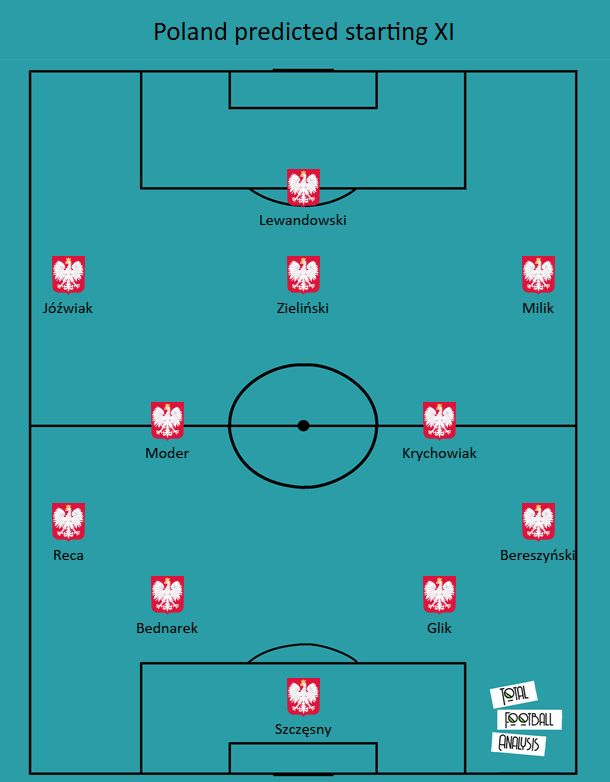
Despite the fact that Sousa used a plethora of formations in the last period, the 4-2-3-1 remains the formation that suits this team best and Poland would more likely use it more than once at least in this tournament since it exploits the players’ strengths perfectly and gives a balance to both the attacking and the defensive phase. Poland were successful in getting positive results against tough teams using this formation this year, and it is enough to say that Poland drew with Italy and disturbed them using the 4-2-3-1, and won 3-0 against Bosnia and Herzegovina using the same formation. This further implies that it suits the team especially in transition and when attacking.
As a goalkeeper, Wojciech Szczęsny has got a clear advantage over his teammates to be the starting goalkeeper since the Juventus’ player is currently at the peak of his career and his performances are definitely more convincing than the other Polish goalkeepers.
In defence, Kamil Glik and Jan Bednarek will more probably form the defensive duo since both players have been playing regularly with their teams, Benevento and Southampton, as they are also better than Paweł Dawidowicz, Kamil Piątkowski, and Michał Helik in terms of performances. Moreover, those two players have been used to playing with each other and there is already a good chemistry between them, and that’s why Sousa has been usually relying on them in all “big” games.
As a right-back, Bartosz Bereszyński will be the starting player in this Euro 2020 since he has been always present in Poland’s line-up this year and his performances were solid, whereas Paweł Dawidowicz can be used as a second choice. And on the left flank, competition is present between Arkadiusz Reca Maciej Rybus and Tymoteusz Puchacz since Arkadiusz Reca was left out of the squad. Rybus is the favourite to be a starter thanks to his tactical maturity, while Puchacz would also start in some of the matches as he can be useful for the team given his pace and attacking contribution.
The midfield will be composed of two defensive midfielders, Lokomotiv Moscow’s Grzegorz Krychowiak and Brighton’s Jakub Moder. These two players will be favoured over the other midfielders since they provide more security in midfield thanks to their height and to their defensive abilities, but at the same time they are good passers with Krychowiak being the dynamo of the team. Then, Mateusz Klich and Karol Linetty can be impactful subs in the course of the game.
In front of them, Napoli’s Piotr Zieliński would play as an advanced playmaker with both Kamil Jóźwiak and Arkadiusz Milik on the wings. Zieliński can be one of the team’s most important players in this tournament if exploited accurately, and by putting him near the final third, he can be very dangerous thanks to his key passes and shooting abilities, while both Jóźwiak and Milik will try their best to exploit counter-attacks thanks to their pace and serve the team’s striker and captain, Robert Lewandowski.
Both wingers however can be replaced by Przemysław Frankowski or Przemysław Płacheta in the course of matches to provide more freshness at delicate times while Karol Świderski and Dawid Kownacki can both be very useful subs whenever Lewandowski needs to get rested.
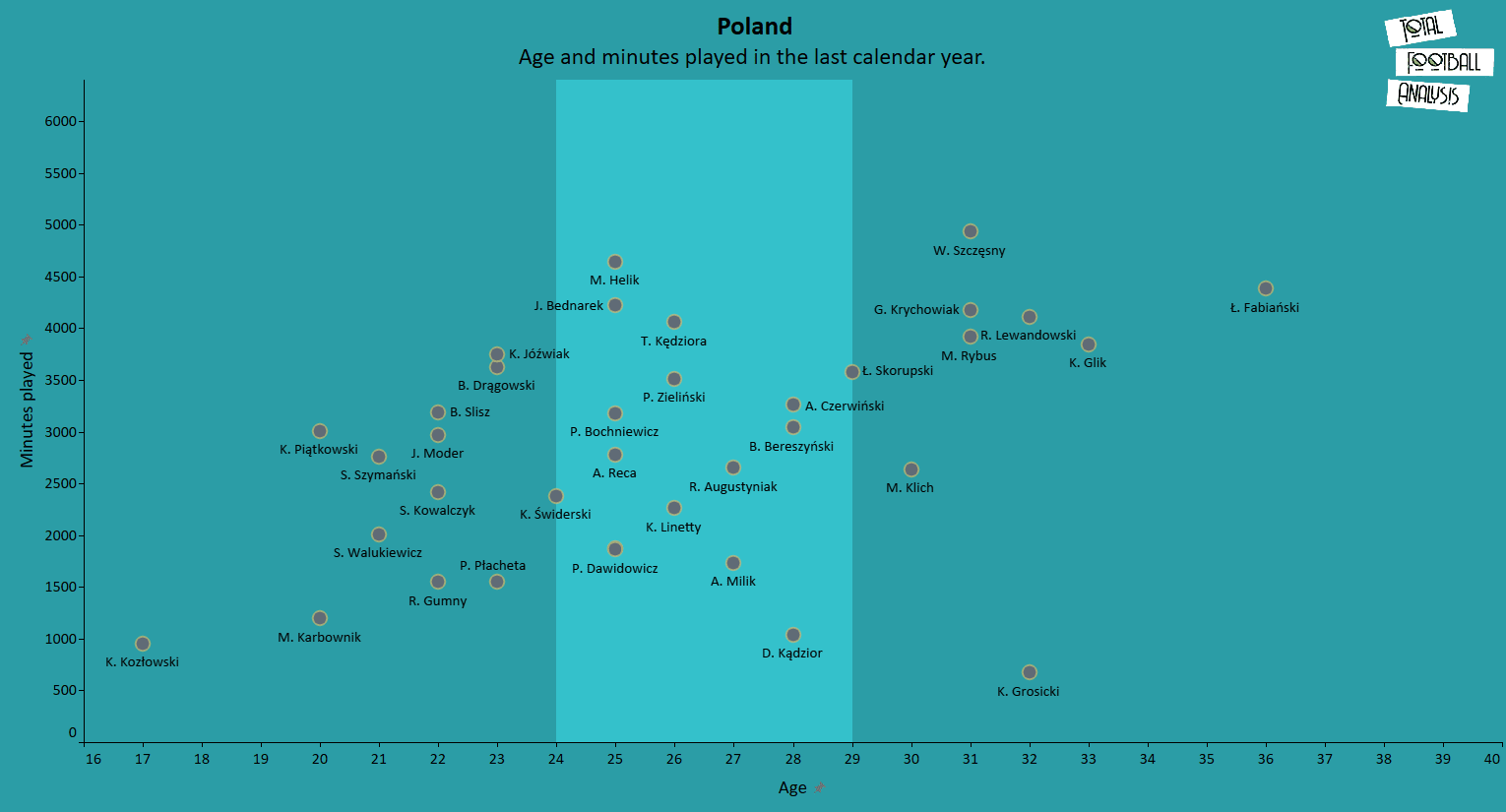
Concerning player ages, Poland’s predicted starting players form a mixture between players beyond their peak, others currently at their peak, and two players in the youth zone. This would work in Poland’s way since such a balanced mixture between experience, youth, and players at their peak, will form a solid team capable of facing stronger teams with a lot of confidence and determination. In fact, even experienced players who are beyond their peak such as Lewandowski, Szczęsny, Glik and Krychowiak are still performing at a high level and their statistics show that they can still compete in such big tournaments and create the difference for Poland.
ATTACKING PHASE
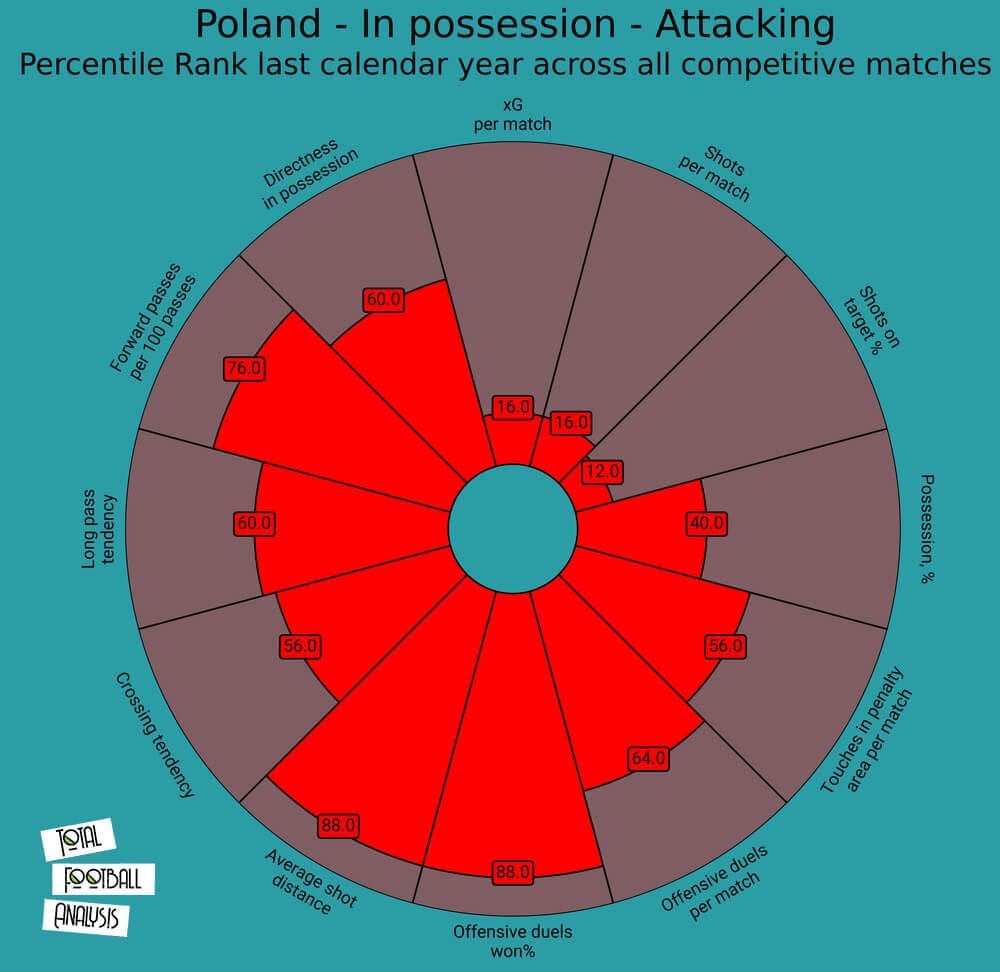
Poland’s attacking performance is often based on counter-attacks especially when they play against powerful teams, which explains the low possession average of the team. Nevertheless, the team relies on wingers and on attacking midfielders such as Zieliński to provide Lewandowski with key passes or go for individual penetrations inside the box. In this regard, Jóźwiak has been impressive since he scored numerous goals by penetrating from the left-wing with the help of Lewandowski who often gives key passes even when he is marked, just like you can see below.
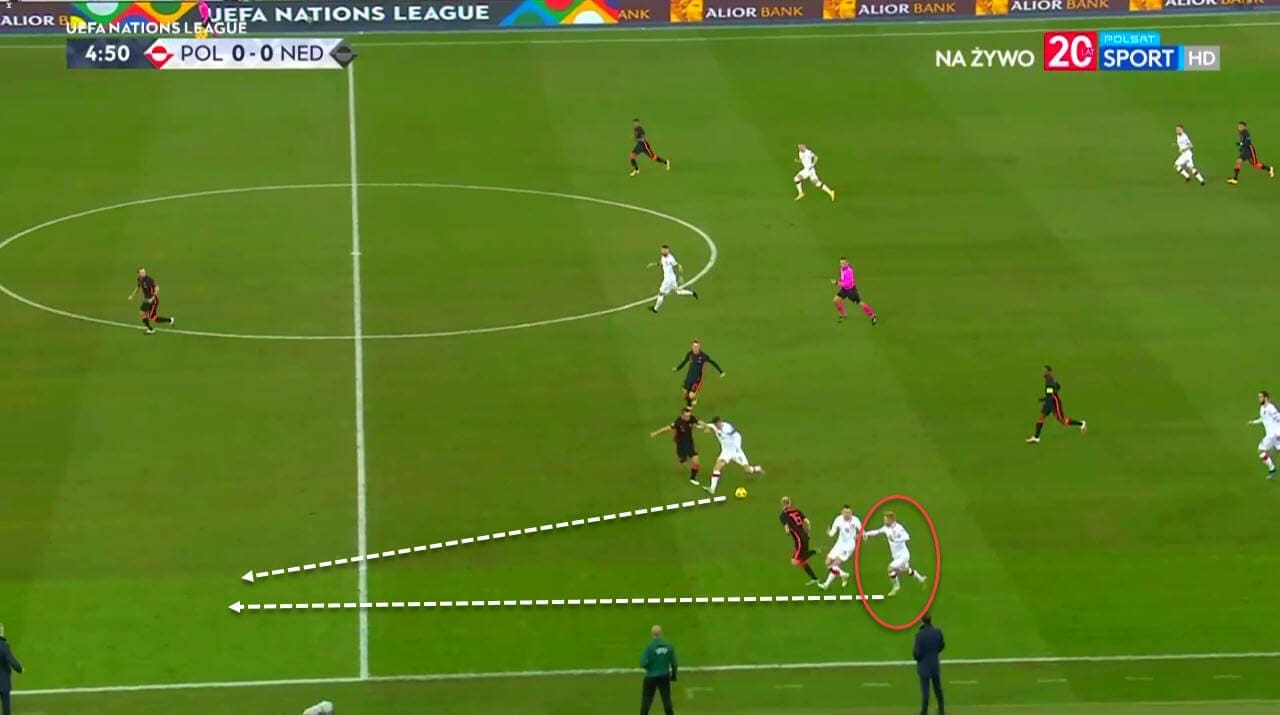
Poland rely a lot on vertical and realistic football, and this can explain the high average of directness in possession and forward passes per 100 passes. This style of play suits Poland’s tactical plans which rely on fast players on the wings, shooting from distance, serving Lewandowski, and alternating between crossing and penetrating towards the box. In addition, Poland’s ability to win a lot of offensive duels per match needs to be credited as it is very important and it just shows how efficient Poland are in attacking duels.
However, both their xG and the number of shots per match need to be improved to be able to disturb big teams and score goals when necessary, since defending well is not enough to beat such teams and draws are not always something positive during such tournaments. Moreover, the reliance on Lewandowski and the role he plays in the team is huge, yet, without talented attacking players and midfielders, Lewandowski will not be able to take Poland faraway in the competition, and that’s why having players like Jóźwiak, Zieliński, Milik, Krychowiak and Moder will be very important in the long run.
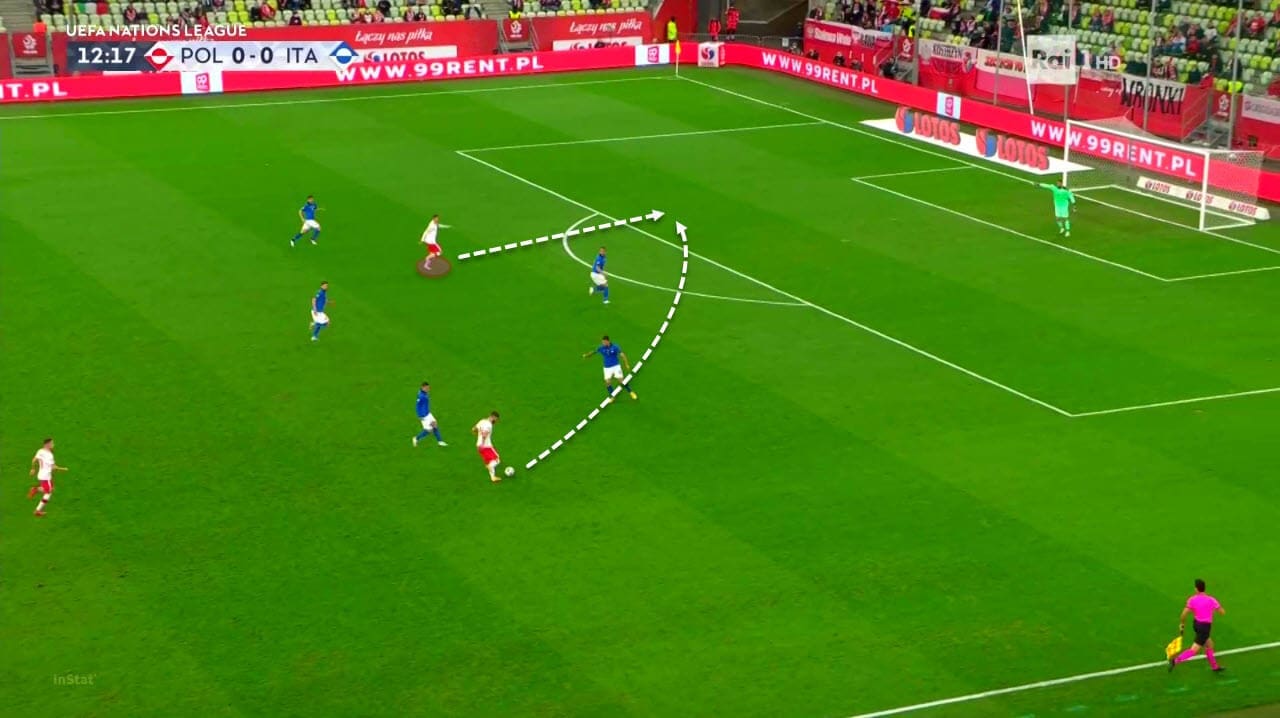
Here, we see how as soon as Poland’s players intercept the ball and start counter-attacks, they immediately aim at passing to Lewandowski if he is unmarked, because they know that these chances don’t come often and a player like Lewandowski do not find himself free from marking a lot in a match. That’s why when such situations occur, Poland’s wingers and midfielders tend to give through passes to their striker as soon as possible to allow him to shoot before defenders surround him.
As you can see in the following picture, this happens both from the right and the left wing, and it all depends on Lewandowski’s accelerations and concentration because these things will determine the player’s success in a match especially when facing fast and attentive defenders, which will be the case especially against Spain and Sweden.
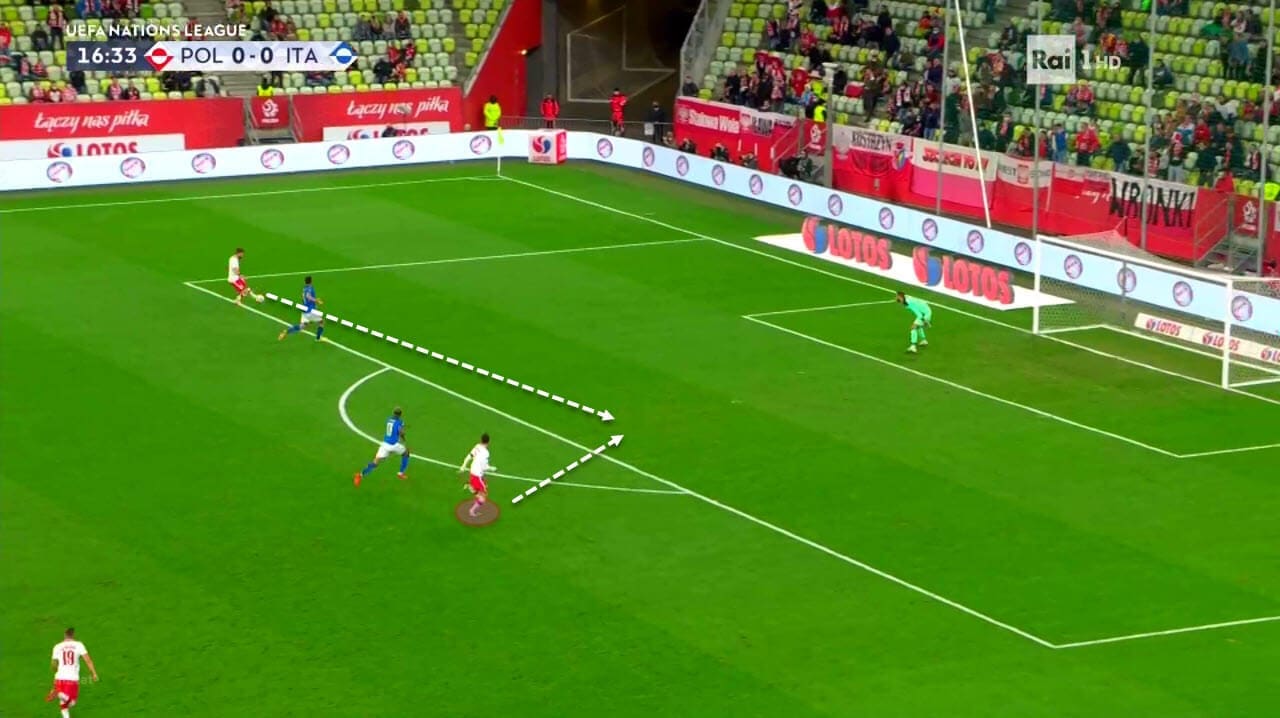
In addition to the reliance on Lewandowski’s finishing abilities, Poland can also use the wingers in a way that enables them to contribute in scoring goals. In fact, players like Jóźwiak, Milik, Frankowski, Płacheta move a lot and we find them inside the box so often, this helps in providing more passing options to midfielders as it gives these players the chance to shoot and score, just like what happened in this action. Jóźwiak here saw the empty space left by Hungary’s defenders and positioned himself inside the box while waiting to get a through pass from his teammate before scoring a goal with a lot of confidence. This highlights the fact that Poland do also have some good attacking players who can score goals whenever Lewandowski is not having his best game or when he is being marked a lot, which gives Poland more winning chances as it improves the quality of their attacks.
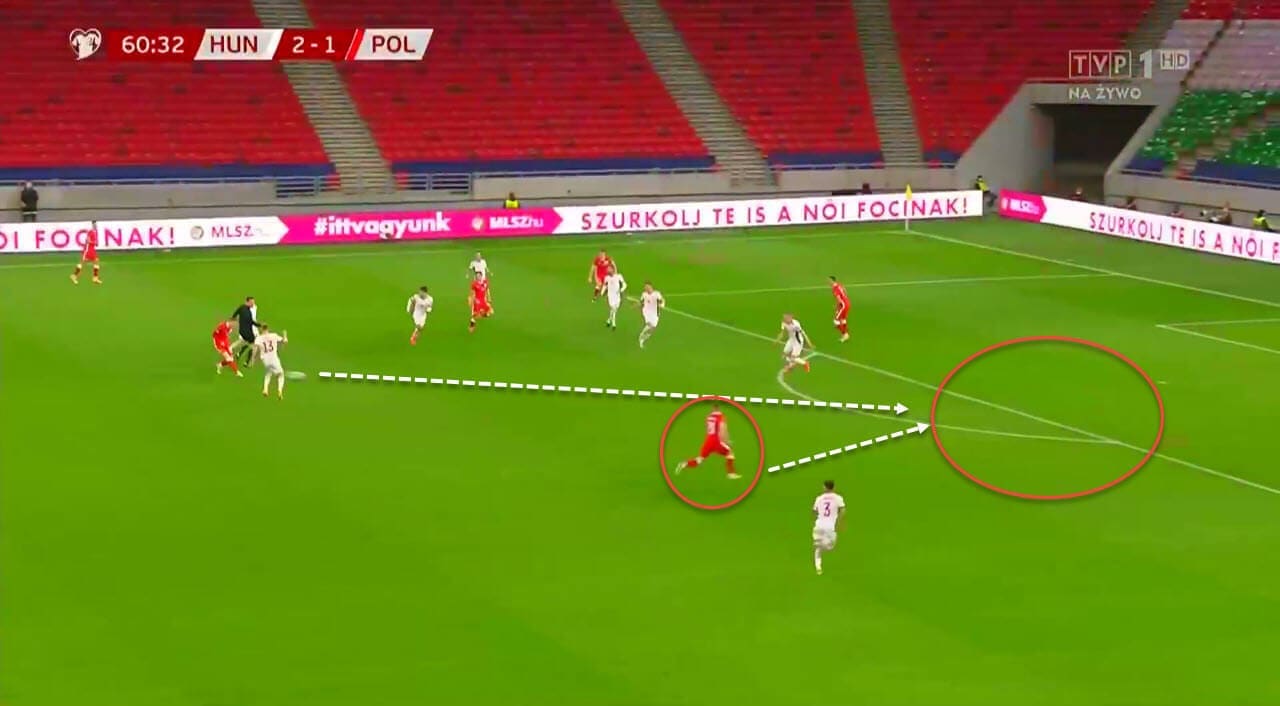
DEFENSIVE PHASE
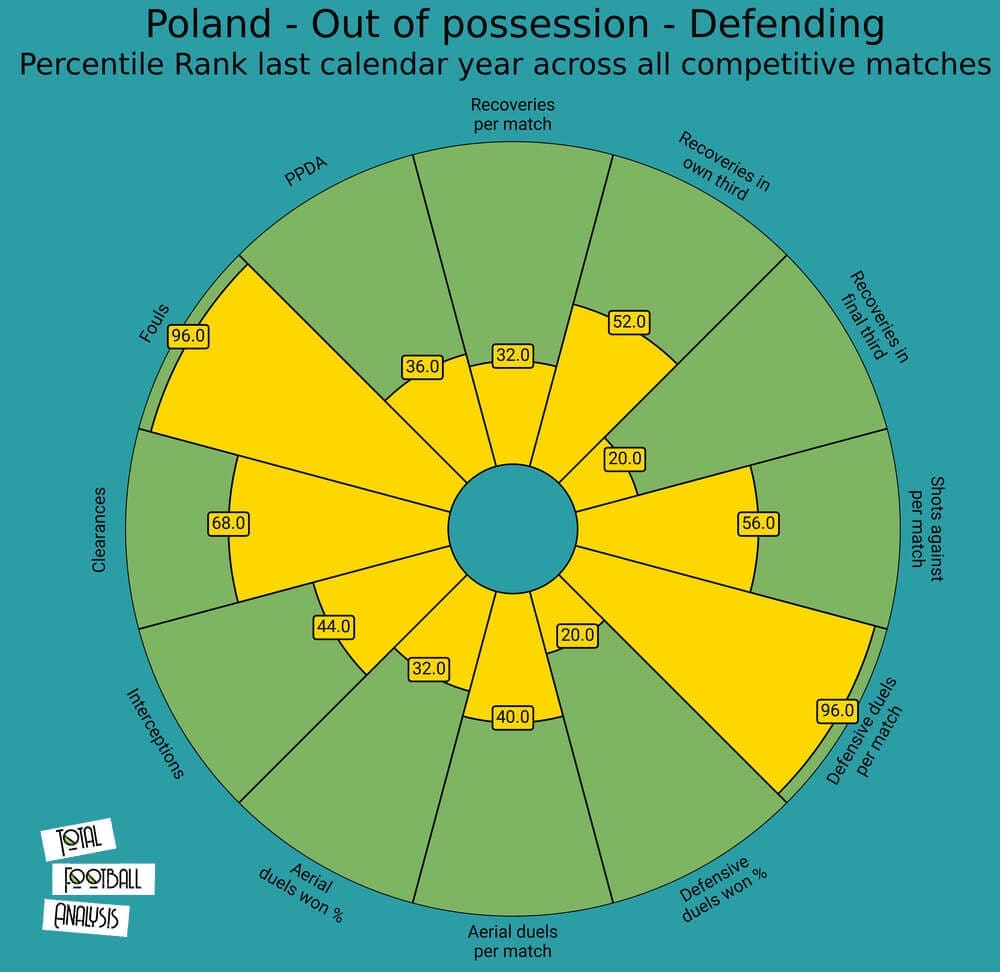
When it comes to their defensive performance, Poland have an organised backline with many decent players competing in some of the top European leagues. Sousa has been relying mainly on the Glik – Bednarek defensive duo with Bereszyński and one of Rybus or Puchacz as full-backs. The overall statistics of this defence tell us that they make a huge number of fouls and this implies that they are very aggressive against their opponents.
Such a style can be a double-edged sword because aggressivity may result in yellow and red cards and this would not serve Poland in the long run since they risk getting important players suspended. But at the same time, aggressivity without committing dangerous mistakes can also be considered as a positive thing that can enable Poland to avoid conceding a lot of chances, yet, defenders will need to work on decreasing the number of fouls made per match because they will face teams who are powerful at executing set-pieces as well.
Moreover, Poland’s defence has been conceding way too much defensive duels per match according to this chart, which means that they retreated a lot and waited for their opponents to attack. And this can also be a weakness for the team since some teams such as Spain can punish their opponents even when retreating with numbers. What makes this even worse, is that Poland win only 20% of defensive duels, which implies that their back line was not able to make a real difference in terms of stopping attacks this past year, and this needs to be improved ahead of the Euro 2020.
Nevertheless, the fact that Poland played mainly against some of the best European teams this season explains these defensive statistics but at the same time it shows that Poland are more likely to concede goals against teams who attack well.
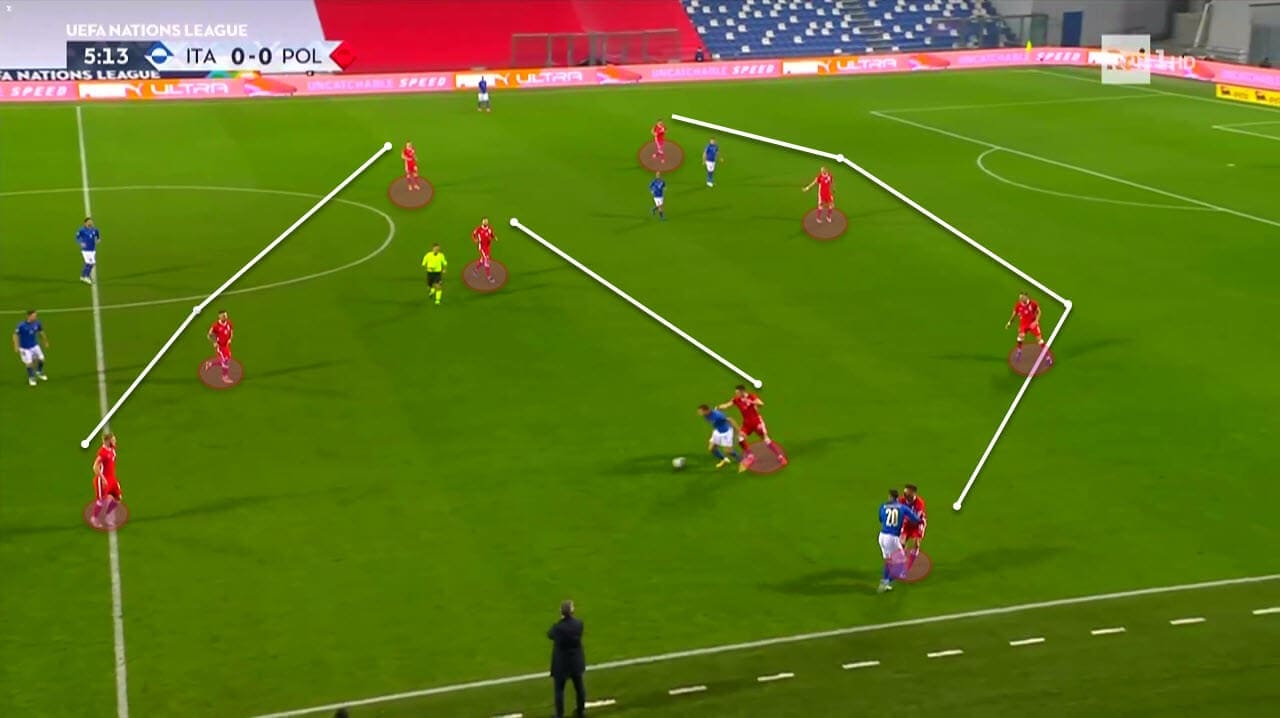
As you can notice from the image above, Poland often line-up according to these positions when playing according to the 4-2-3-1 formation. These out of possession positions enable the team to resist the opponents’ attacking attempts by putting some pressure when they are building up from the back using Lewandowski and the three attacking players mainly. Then, if the ball reaches midfield like it happened in this action, Moder and Krychowiak would mark their direct opponents’ tightly to oblige them to get rid of the ball while at the same time the three attacking players try to close backward passing lanes to intercept a possible pass.
Furthermore, the back-line often remains narrow to avoid attacks from the middle, while both full-backs make sure to mark the wingers as soon as they receive the ball, yet Poland commits marking mistakes at times which results in goals, even though they are good in aerial duels and in recovering the ball in their own third.
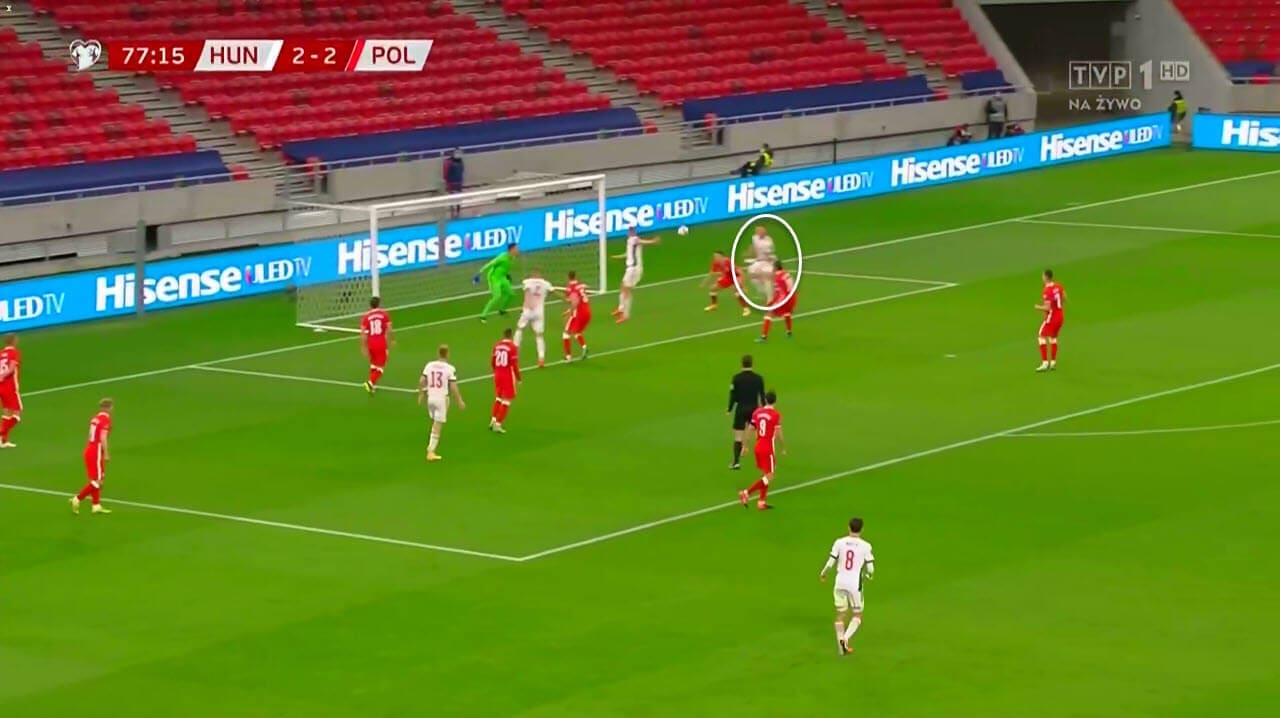
In this example we wanted to highlight how Poland’s defensive positioning is not always accurate since at times they commit concentration mistakes that allow opponents to escape from their marking. Hungary’s player here was able to do just that when he saw Reca standing in front of him instead of being just near him to avoid bad scenarios. Reca however got distracted and was not aware of the danger that could occur by leaving a player behind him in such situations, and the result was a goal by that specific player. Poland will therefore need to improve their marking inside the box to avoid conceding such goals in the Euro 2020.
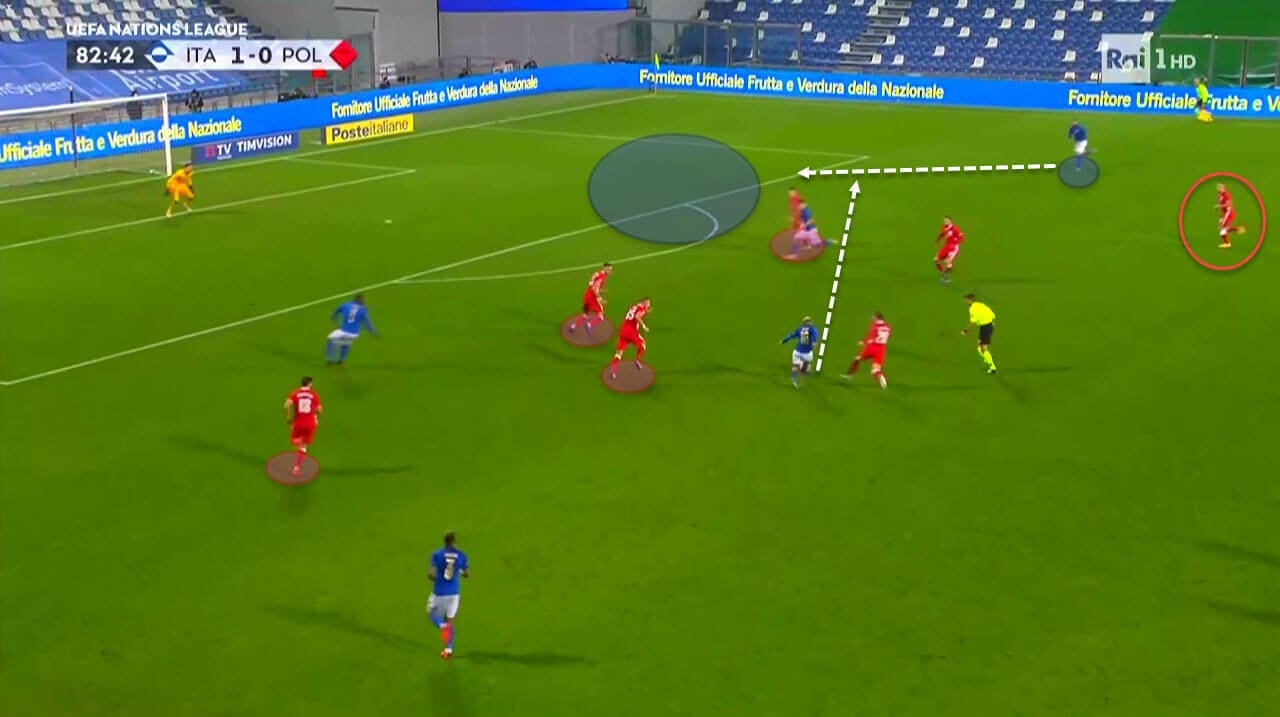
Another marking issue is showcased here in the match against Italy when the four defenders were not positioned as they should be during an Italian attack, both Glik and Bednarek were too close to each other and this obliged Reca to mark Barella who was running towards the box. However, by marking Barella, Reca left his direct opponent Berardi alone and Grosicki was coming back but did not cover for his teammate on the flank. This switch of positions at the end resulted in a goal from Berardi which highlights the importance of Glik and Bednarek’s positioning because if they get distracted in a few seconds, the whole defence becomes messy and big teams do not miss the chance to exploit such opportunities.
TRANSITIONS
Poland rely on the two defensive midfielders heavily in transition given that they both link defence to attacking midfielders and to attackers, and in most Poland’s counter-attacks these two players tend to pass either to the striker if he is unmarked or to one of the wingers. Then, the wingers would either cross towards the striker, pass to the advanced playmaker or cut inside. In the following example you can see how Krychowiak immediately anticipated Italy’s wrong pass and gave the ball to Lewandowski to launch the counter-attack.
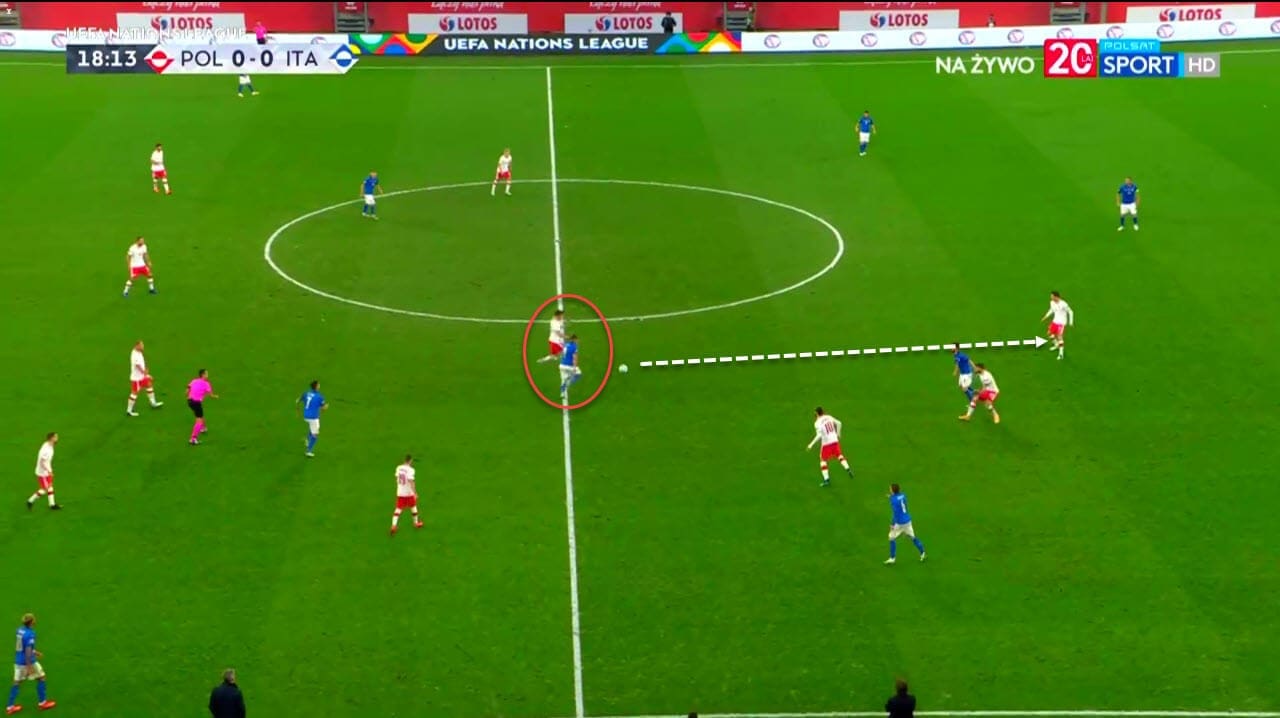
In most of the other cases however, Poland midfielders pass automatically to the wingers since those players are the fastest in the team and do often advance prior to everyone during counter-attacks. In this example of such situations you can notice how Krychowiak instantly gave a through pass to Jóźwiak as soon as he intercepted Netherlands’ pass.
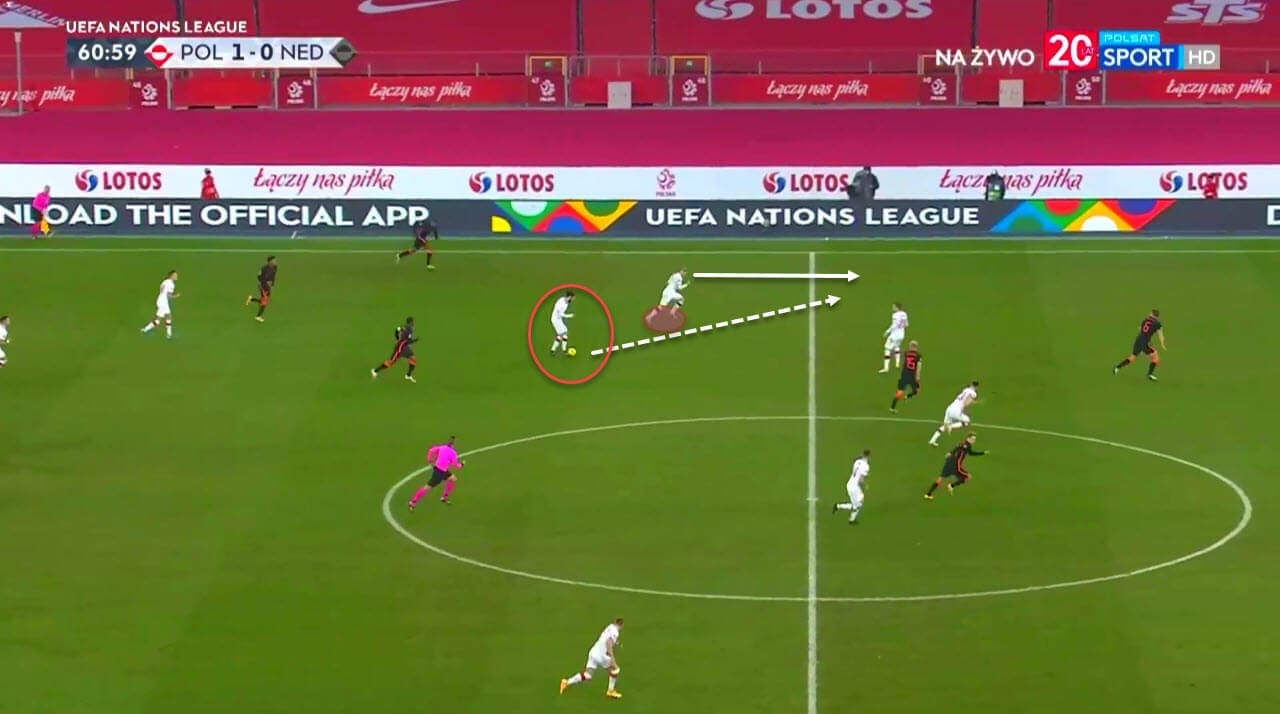
A different plan occurs however when Zieliński retreats to collect a pass or intercepts a ball to start a counter-attacking situation. Napoli’s playmaker does not act like Poland’s defensive midfielders, instead he runs with the ball, dribbles past players whenever he can to reach the final third and then he thinks about giving key passes to one of the other attacking players. This determined and skilful attitude gives the midfield more creativity and allows the team to have an extra leader in the team who is valuable especially in counter-attacks.

FORWARDS
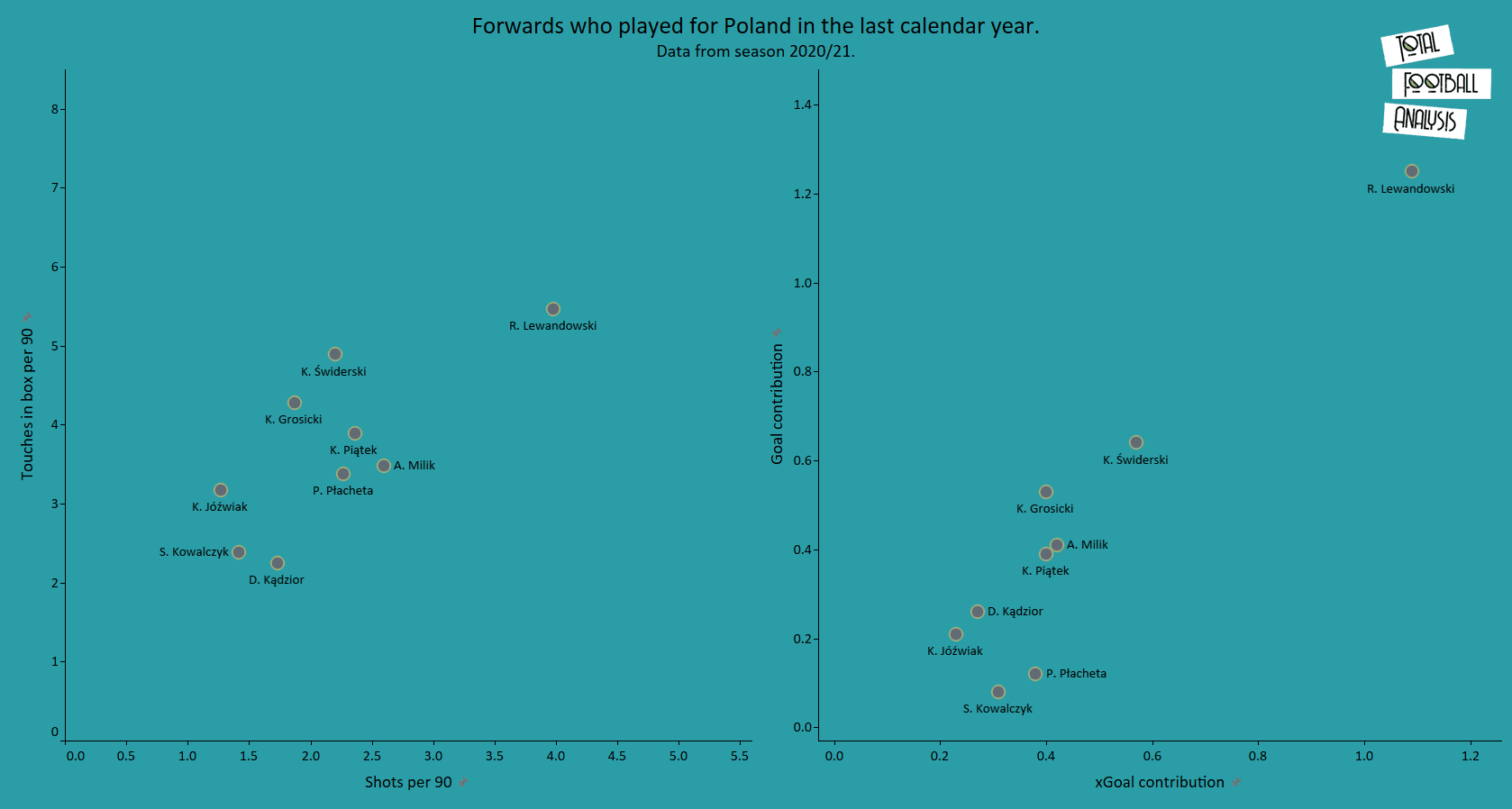
Poland has got some very decent attacking players, and most importantly, they have one of the best European strikers at the moment; Lewandowski. And even though Bayern Munich’s striker has got some high statistics especially in terms of xG, goal contribution and the number of shots per match, the other Polish attackers are way behind him in terms of numbers. This leads us to be more familiar with Poland’s attacking plans since they rely heavily on Lewandowski by trying to give him passes from different players and in various situations.
It means that both wingers tend to cross towards the box searching for Lewandowski’s header, while at the same time Zieliński and the other midfielders will always wait for the right time to give through passes to Lewandowski. Moreover, Sousa knows that passing to Lewandowski will not always be the right thing to do since defences will always try to mark him tightly, and this is why having a player like Milik who is naturally a striker, would help a lot in providing extra attacking depth to the team as he also be an additional dangerous player inside the box given his good aerial abilities and physical strength.
MIDFIELDERS
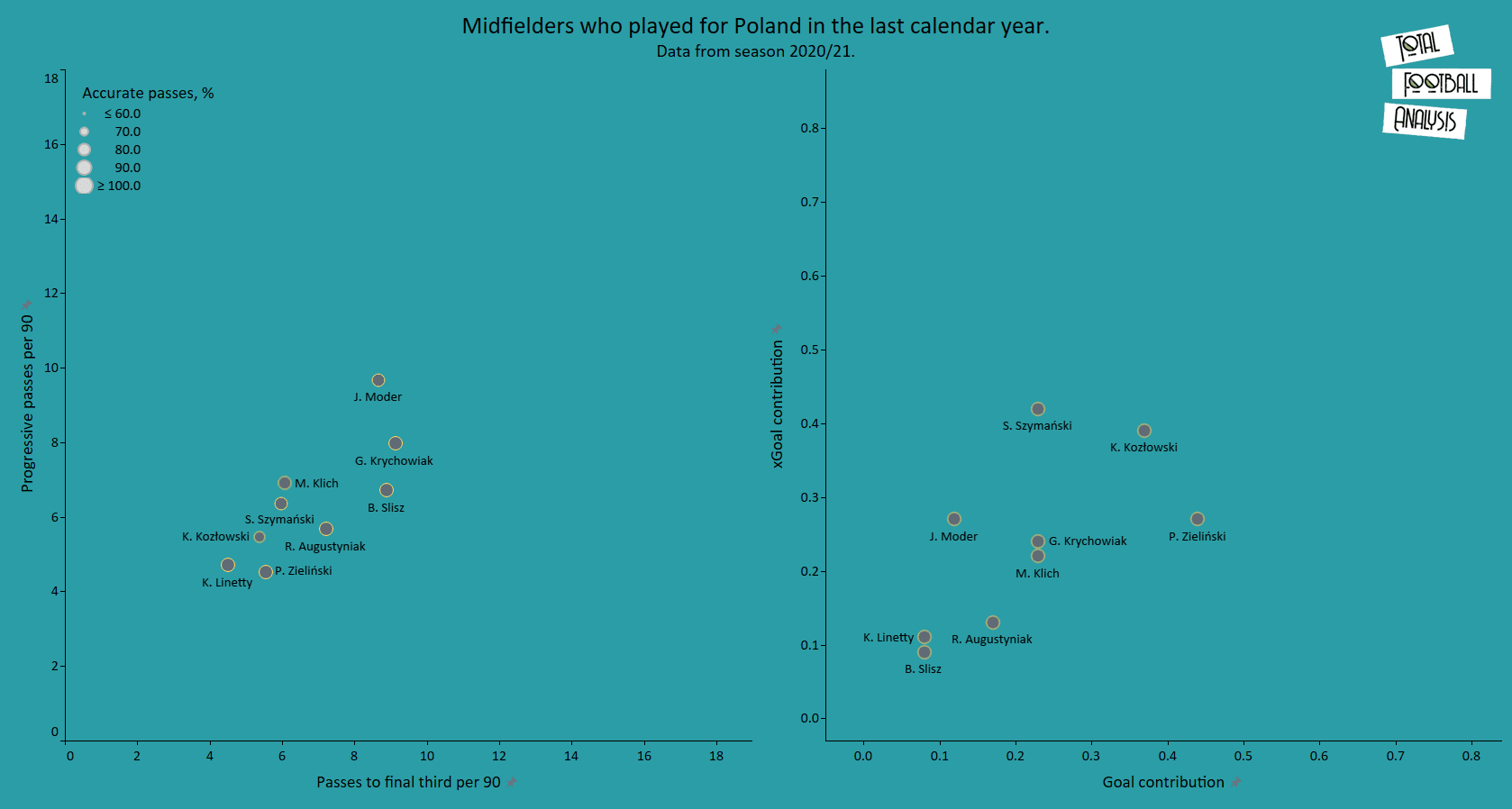
In order to assess the quality of Poland’s midfielders we first need to identify the roles of these players. For instance, for players like Linetty, Klich, Moder it is normal to not have high goal contribution numbers or a high average of passes to final third since these players’ roles are mainly defensive duties which often include intercepting passes, marking attacking midfielders in the final third, and clearing the ball from the danger zones as well as initiating counter-attacks.
However, contributing in goalscoring chances is not their duty. And that’s also why we see Zieliński being the best midfielder in terms of goal contribution, knowing that one of his roles is to provide key passes and help in creating goalscoring chances through passes, even though he does not have a high average of passes towards the final third.
We can also detect that both Krychowiak and Moder are the best two midfielders when it comes to progressive passes and this is one of the reasons why the two players are more likely to be the starters in the Euro 2020.
DEFENDERS
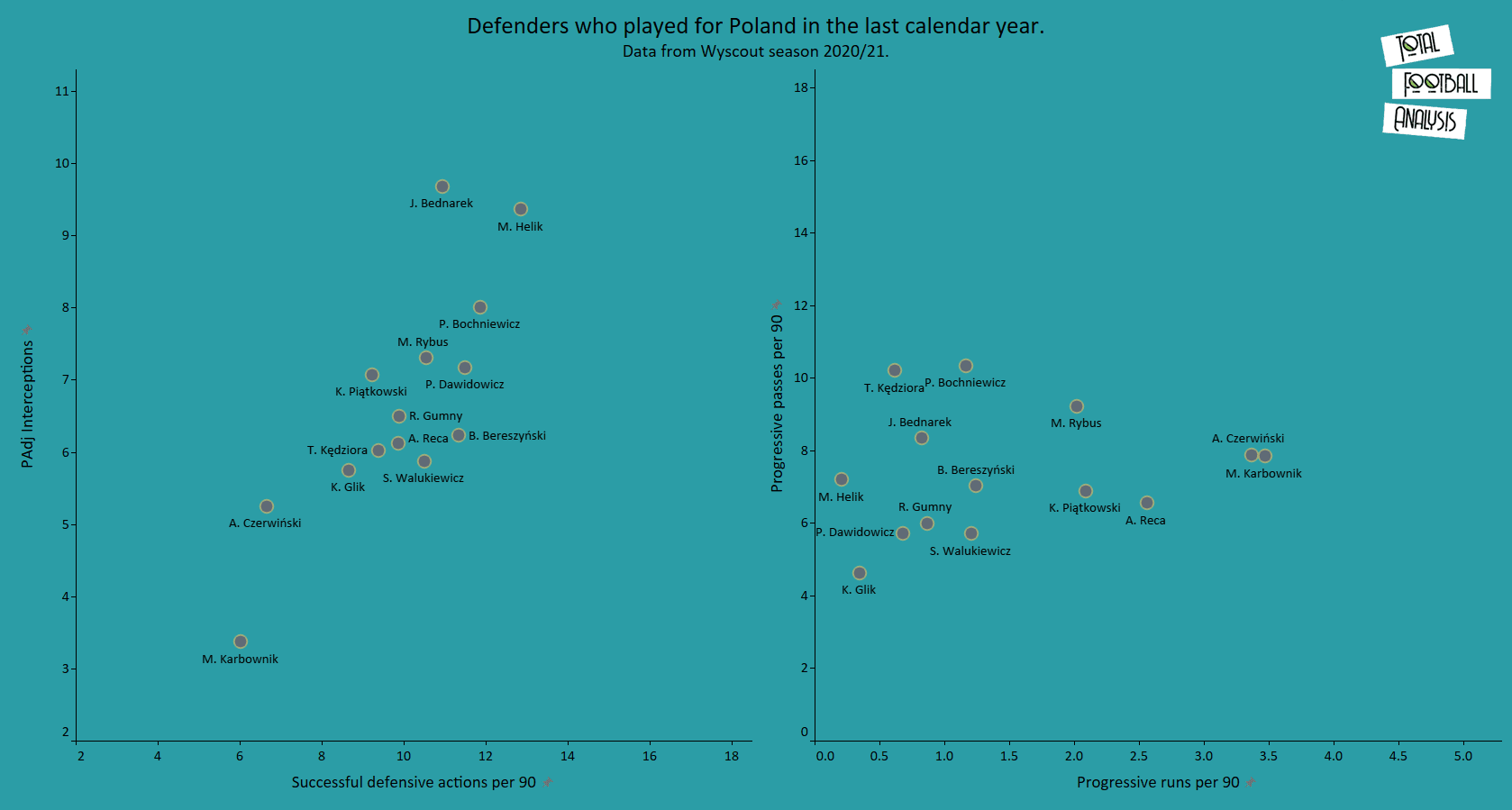
For defenders, Poland has got a mix of talented and experienced defenders competing for starting spots in this Euro 2020. In the 2020/21 season, many of these players have been over performing and we can highlight Helik and Bednarek among these players especially because they combine a very good average of interceptions per match and a high number of successful defensive actions per match. The rest of defenders however are all close to each other in terms of these statistics and this shows that the level is quite similar between these players.
The chart also tells us about players who opt for vertical and progressive passes and runs, and these include Michał Karbownik, Jakub Czerwiński, Paweł Bochniewicz and Tomasz Kędziora. And despite being important, these progressive passes and runs do not determine the quality of a defender but the defender’s ability to contribute in the build-up phase and to not be passive when the team is in possession. And that’s why some players like Glik who do not have excellent averages in progressive passes and runs are still one of Sousa’s favourite defenders in the team. Glik’s experience and tactical awareness as well as his physical strength are very important to Poland and along with Bednarek, they form an excellent defensive duo.
BEST PERFORMER
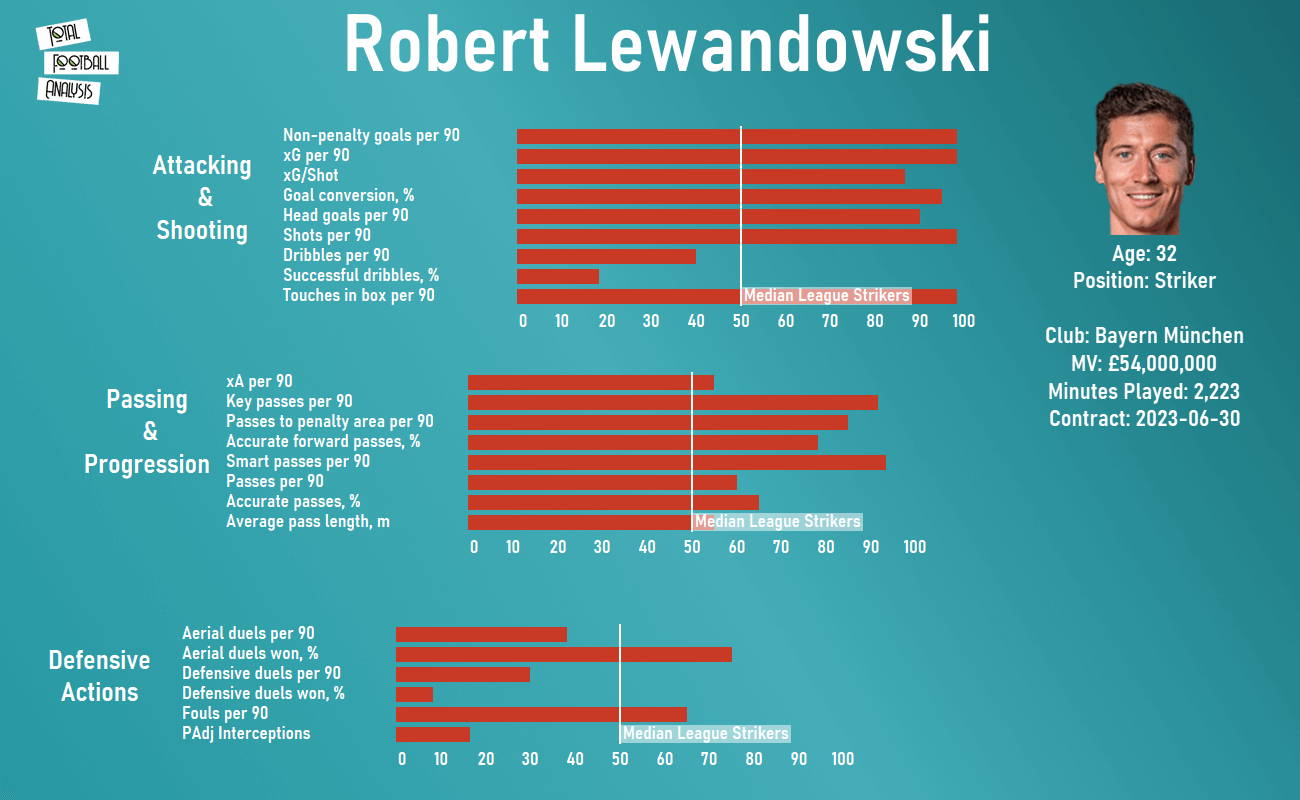
Lewandowski is by far Poland’s best player and he is more likely to be Poland’s best player during the tournament as well. He is actually considered as one of the best strikers in the world and this can be easily noticed when watching his goal contributions or when looking at his Bayern Munich and Poland’s statistics. This player has got some very high averages in terms of attacking and shooting.
His number of non-penalty goals, expected goals, shots and touches in the box per match are all phenomenal and exceptional while his expected goals per shot, goal conversion and head goals per match are also excellent but to a lesser degree. And all these very good statistics can only serve Poland in a positive way in the attacking phase since having a player who knows how to exploit half chances to score goals can only be very beneficial to any team in the world.
The only drawback for Lewandowski however is his dribbling rates, but we all know that dribbling is not what matters most for strikers since scoring, giving assists, positioning well and moving intelligently without the ball are the main roles that strikers tend to excel at.
In terms of passing, Lewandowski’s passing statistics are way above the median and this is not something common for strikers. In fact, Lewandowski has got some very high averages for key passes, smart passes and passes to penalty area per match while he is also good at providing forward and accurate passes per match.
For defensive actions, Lewandowski can improve in some of these statistics such as in defensive duels and interceptions mainly, but at the same time he is very good in aerial duels and in committing tactical fouls.
Lewandowski can be Poland’s best weapon during this tournament especially in attack while some other players may also shine, namely Jóźwiak, Zieliński, Milik, Krychowiak and Moder.
PREDICTIONS FOR THE TOURNAMENT
Considering the group in which Poland will play in this tournament, the team has got high chances to qualify among the top two teams if Sweden do not create a small surprise and qualify as the second team along with Spain. If that happens, Poland will more likely qualify as one of the best-placed thirds and reach the knockout phase.
However, they would eventually be playing against a top-placed team from group B or C in the round of 16 if they qualify as a best-placed third, and this will make their qualification to the quarter-finals more complicated. So, if no surprises happen, Poland will reach the round of 16 and try to advance to the quarter-finals, but they will most probably get eliminated at this stage.





Comments